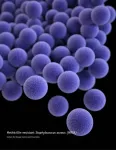(Press-News.org) Driven by the overuse of antimicrobials, pathogens are quickly building up resistances to once-successful treatments. It’s estimated that antimicrobial-resistant infections killed more than 1 million people worldwide in 2019, according to the World Health Organization.
“There are worries that at the rate things are going, in perhaps 20 or 30 years, few of our drugs will be effective at all,” said Xuefei Huang, a Michigan State University Research Foundation Professor in the departments of Chemistry and Biomedical Engineering.
“This would bring us back to the pre-antibiotic age.”
Now, in a new Nature Communications study, Huang and his collaborators have reported a breakthrough that will help tackle this global threat head-on. Specifically, the team has created a promising vaccine candidate for antibiotic-resistant bacteria.
Bacterial vaccines, along with antibiotics, are a crucial tool in the fight against deadly microbes.
In the latest paper, Huang announced several discoveries that will help the development of a carbohydrate-based vaccine for infections caused by Staphylococcus aureus and its “superbug” relative methicillin-resistant Staphylococcus aureus, or MRSA.
Staph aureus, or staph, and MRSA are among the most prevalent causes of bacterial infections.
Using an innovative delivery platform created by the Huang group at MSU, the team’s preclinical vaccine formulation offered high levels of immunity from lethal levels of staph and MRSA in animal trials.
With this work, Huang and his team have expanded the frontiers of vaccine science, equipping fellow researchers with new knowledge to improve and refine future bacterial vaccines.
Carbohydrate hurdles
To develop a vaccine, researchers must identify an effective antigen. This is a substance or molecule that the body flags as foreign, helping to trigger an immune response and the creation of antibodies that will fight future infection.
While most vaccines rely on protein antigens, Huang is an expert in the chemistry and biology of carbohydrates. These are chemical compounds comprised of saccharides, or sugars.
Developing carbohydrates to use as antigens in vaccines comes with its own unique challenges and advantages.
“Sugar structures are very specific to certain bacteria,” Huang explained. “A vaccine that works against one bacterium might not work at all against another, even if they’re very similar.”
This is why a single dose of a bacterial vaccine can contain many different antigens. For instance, the “20” in Pfizer’s PREVNAR 20 pediatric pneumonia vaccine refers to the 20 unique strains of bacteria it protects against.
If researchers can develop an antigen that’s shared among many — if not all — bacteria, vaccination coverage would be greatly improved.
Gerald Pier, professor of medicine at Harvard Medical School and Brigham and Women’s Hospital and a collaborator on the latest MSU-led paper, has studied one such antigen candidate for years.
Polysaccharide poly-β-(1−6)-N-acetylglucosamine, or PNAG, is a carbohydrate found on the cell wall of staph, many other bacteria and even fungi. This prevalence makes it extremely useful, offering potential protection against numerous pathogens at once.
By examining PNAG as an antigen candidate for staph, Pier, Huang and their colleagues are unlocking the secrets needed to make a more effective vaccine.
A molecular mosaic
Imagine creating a mosaic made from multicolored tiles.
Arrange these tiles in a precise pattern and you’ll end up with a striking work of art. Move just a few tiles around, however, and you’ll find yourself looking at a very different image.
PNAG — and carbohydrates in general — are kind of like mosaics. There are myriad ways to arrange their individual pieces, but only a select few have the effects that researchers desire.
Just as changing a few tiles in a mosaic can give you a completely different image, swapping out these pieces or even changing their location within a PNAG molecule changes its performance as a potential antigen.
“We were very interested in this molecule and these different patterns,” Huang said.
“We wanted to know: Was there a best combination to improve Staph aureus vaccine efficiency, and does the arrangement matter?”
The pieces that Huang and his colleagues were most interested in were biologically active molecular components known as amines and acetyl groups that adorn PNAG’s sugary backbone.
PNAG molecules can contain many amines. These amines can be acetylated, meaning they’re modified with an acetyl group, or they can be free and not bound to anything else.
Currently, most researchers investigating PNAG as an antigen focus on forms of the sugar that are either fully free or fully acetylated.
Huang and his colleagues believed there were promising opportunities in the understudied in-between space where there’s a mixture of free and acetylated amines.
For its research, the team created a library of 32 different PNAG structures. The structures were all pentasaccharides — made from five saccharides — but they differed in how they were decorated with amines and acetyl groups.
By screening these 32 structures with antibody studies, they made their discovery.
“The fine pattern matters quite a bit,” Huang said. “And the impact is drastic.”
An MSU mutant
The team identified two PNAG combinations that were especially promising. Going a step further, the researchers attached them to a groundbreaking vaccine delivery platform.
The platform is based on a bacteriophage, which is a virus that infects bacteria, called Qbeta, also written as Qβ (pronounced “cue beta”). Huang’s team modified the bacteriophage, giving it the power to deliver antigens for carbohydrate-based pathogens.
PNAG and other carbohydrates typically don’t provoke strong immune responses in our bodies, but the mutant Qbeta, or mQβ, helps create an enhanced reaction.
This breakthrough delivery platform — which also has vaccine applications for cancer and even opioid addiction — earned Huang MSU’s 2024 Technology Transfer Achievement Award.
When coupled with mQβ, Huang and his collaborators found that the two most promising PNAG pentasaccharides offered high levels of protection in mice against staph and MRSA.
In animal studies, the team’s new vaccine construct outperformed another PNAG-vaccine delivery system that is currently in human trials.
The team also found their formulation had minimal impact on the biochemistry of the gut microbiome in tests.
As the team prepares for future tests of their new vaccine candidate, Huang is looking forward to the role bacterial vaccines will play in the larger fight against antibiotic resistance.
“Vaccines reduce the overall infection rate, which means there’s less of a need for antibiotics,” Huang said. “This reduces the chance for bacteria to develop resistance, breaking the cycle.
“The two go hand in hand.”
END
A vaccine to fight antibiotic resistance
MSU, Harvard Medical School team up to expand vaccine science’s role in the fight against MRSA and other infections
2024-04-24
ELSE PRESS RELEASES FROM THIS DATE:
European Hormone Day 2024: Endocrine community unites to raise public awareness and push for policy action on hormone health
2024-04-24
European Hormone Day 2024: Endocrine community unites to raise public awareness and push for policy action on hormone health
European Hormone Day returns for the third year today, 24 April 2024, putting a spotlight on the vital role of hormones in chronic diseases such as diabetes, thyroid disorders, cancer and obesity, as well as many rare diseases.
The European Society of Endocrinology (ESE), the European Hormone and Metabolism Foundation (ESE Foundation), and partners from key groups and organisations across Europe and beyond will join forces to highlight simple steps we can all take towards better hormone health.
This builds on the success of the previous ...
Good heart health in middle age may preserve brain function among Black women as they age
2024-04-24
Research Highlights:
Middle-aged Black women with better heart health were less likely to show a decline in mental function compared with middle-aged Black women with worse heart health.
In this study, heart health was unrelated to cognitive decline among middle-aged white women.
A clinical trial is required to confirm if improving heart health among middle-aged Black women may slow cognitive decline and decrease the risk of dementia.
Embargoed until 2 a.m. CT/3 a.m. ET Wednesday, April 24, 2024
DALLAS, April 24, 2024 ...
The negative effects of racism impact sleep in adolescents
2024-04-24
Sleep and sleep disturbances have consequences for the development of adolescents and young adults. In a new article, researchers examine sleep during these periods, focusing on the effects of ethnic and racial discrimination. They conclude that improving sleep may boost health for all youth, but especially for those affected by racism.
The article, by researchers at Fordham University and the University of Illinois at Urbana-Champaign, appears in Child Development Perspectives, a journal of the Society for Research in Child Development.
“Discrimination ...
Study uses wearable devices to examine 3- to 6-year-olds’ impulsivity, inattentiveness
2024-04-24
Why do some young children struggle to sit through a story one day but not the next? Why do they rush impulsively into one activity but not another? Parents and teachers often focus on individual differences as they prepare children for formal schooling, but traditional measurement approaches make it difficult to study fluctuations in children’s behavior.
In a new study, researchers sought to understand children’s impulsive and inattentive behaviors in early education classrooms by having students use wearable devices called accelerometers to collect an intensive time series of their movement at school. The study found that children modulated their ...
Will future hurricanes compromise New England forests’ ability to store and sequester carbon?
2024-04-24
Nature-based climate solutions can help mitigate climate change, especially in forested regions capable of storing and sequestering vast amounts of carbon. New research published in Global Change Biology indicates that a single hurricane in New England, one of the most heavily forested regions in the United States, can down 4.6–9.4% of the total aboveground forest carbon, an amount much greater than the carbon sequestered annually by New England’s forests.
The work revealed that emissions from hurricanes are not instantaneous—it takes approximately 19 years for downed carbon to become a net emission, and 100 years for 90% of the downed carbon ...
Longest study to date assesses cognitive impairment over time in adults with essential tremor
2024-04-24
Essential tremor, a nervous system disorder that causes rhythmic shaking, is one of the most common movement disorders. A new study published in the Annals of Neurology reveals details on the increased risk of mild cognitive impairment (MCI) and dementia that individuals with essential tremor may face.
The research represents the longest available longitudinal prospective study of rates of MCI and dementia in people with essential tremor. The study enrolled 222 patients, 177 of whom participated in periodic evaluations over an average follow-up of 5 years.
Investigators observed ...
Does a woman’s heart health affect cognition in midlife?
2024-04-24
A new study has found that Black women with poor cardiovascular health may face an elevated risk of early signs of cognitive decline in midlife.
The study, which is published in the Journal of the American Heart Association, included 363 Black and 402 white women who enrolled in the Chicago site of the Study of Women’s Health Across the Nation when they were 42–52 years old. Cognition (measured as processing speed and working memory) was assessed annually or biennially over a maximum of 20 years, with an average follow-up of 9.8 years. A composite index of cardiovascular health (Life’s Essential 8) was calculated ...
Unveiling the mysteries of cell division in embryos with timelapse photography
2024-04-24
The beginning of life is shrouded in mystery. While the intricate dynamics of mitosis is well-studied in the so-called somatic cells – the cells that have a specialized function, like skin and muscle cells – they remain elusive in the first cells of our bodies, the embryonic cells. Embryonic mitosis is notoriously difficult to study in vertebrates, as live functional analyses and -imaging of experimental embryos are technically limited, which makes it hard to track cells during embryogenesis.
However, researchers from the Cell Division Dynamics Unit at the Okinawa Institute of Science and Technology ...
Survey finds loneliness epidemic runs deep among parents
2024-04-24
COLUMBUS, OHIO – A new national survey conducted by The Ohio State University Wexner Medical Center finds a broad majority of parents experience isolation, loneliness and burnout from the demands of parenthood, with many feeling a lack of support in fulfilling that role.
The survey of parents conducted this month found:
About two-thirds (66%) felt the demands of parenthood sometimes or frequently feel isolating and lonely.
About 62% feel burned out by their responsibilities ...
Researchers develop high-energy-density aqueous battery based on halogen multi-electron transfer
2024-04-24
Traditional non-aqueous lithium-ion batteries have a high energy density, but their safety is compromised due to the flammable organic electrolytes they utilize.
Aqueous batteries use water as the solvent for electrolytes, significantly enhancing the safety of the batteries. However, due to the limited solubility of the electrolyte and low battery voltage, aqueous batteries typically have a lower energy density. This means that the amount of electricity stored per unit volume of aqueous battery is relatively low.
In a new study published in Nature Energy, a research group led by Prof. LI Xianfeng from the Dalian Institute of Chemical Physics (DICP) ...
LAST 30 PRESS RELEASES:
UVA’s Jundong Li wins ICDM’S 2025 Tao Li Award for data mining, machine learning
UVA’s low-power, high-performance computer power player Mircea Stan earns National Academy of Inventors fellowship
Not playing by the rules: USU researcher explores filamentous algae dynamics in rivers
Do our body clocks influence our risk of dementia?
Anthropologists offer new evidence of bipedalism in long-debated fossil discovery
Safer receipt paper from wood
Dosage-sensitive genes suggest no whole-genome duplications in ancestral angiosperm
First ancient human herpesvirus genomes document their deep history with humans
Why Some Bacteria Survive Antibiotics and How to Stop Them - New study reveals that bacteria can survive antibiotic treatment through two fundamentally different “shutdown modes”
UCLA study links scar healing to dangerous placenta condition
CHANGE-seq-BE finds off-target changes in the genome from base editors
The Journal of Nuclear Medicine Ahead-of-Print Tip Sheet: January 2, 2026
Delayed or absent first dose of measles, mumps, and rubella vaccination
Trends in US preterm birth rates by household income and race and ethnicity
Study identifies potential biomarker linked to progression and brain inflammation in multiple sclerosis
Many mothers in Norway do not show up for postnatal check-ups
Researchers want to find out why quick clay is so unstable
Superradiant spins show teamwork at the quantum scale
Cleveland Clinic Research links tumor bacteria to immunotherapy resistance in head and neck cancer
First Editorial of 2026: Resisting AI slop
Joint ground- and space-based observations reveal Saturn-mass rogue planet
Inheritable genetic variant offers protection against blood cancer risk and progression
Pigs settled Pacific islands alongside early human voyagers
A Coral reef’s daily pulse reshapes microbes in surrounding waters
EAST Tokamak experiments exceed plasma density limit, offering new approach to fusion ignition
Groundbreaking discovery reveals Africa’s oldest cremation pyre and complex ritual practices
First breathing ‘lung-on-chip’ developed using genetically identical cells
How people moved pigs across the Pacific
Interaction of climate change and human activity and its impact on plant diversity in Qinghai-Tibet plateau
From addressing uncertainty to national strategy: an interpretation of Professor Lim Siong Guan’s views
[Press-News.org] A vaccine to fight antibiotic resistanceMSU, Harvard Medical School team up to expand vaccine science’s role in the fight against MRSA and other infections




